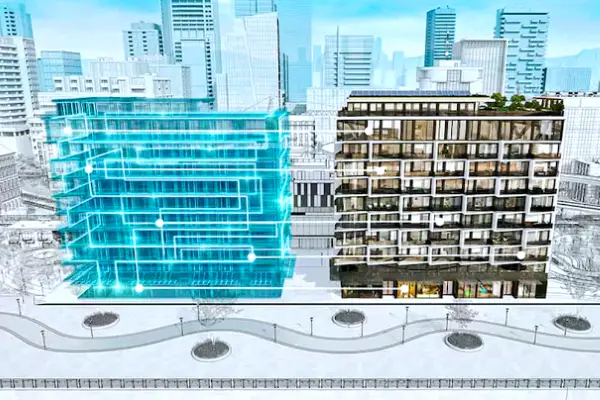
Top 7 BIM Trends in 2025
Building Information Modelling (BIM) has revolutionized the way construction projects are planned and executed. Yet, while BIM is one of the biggest changes in this complex and fast-paced construction industry, it has yet to fully evolve to its full potential.
However, the market share of BIM has grown exponentially: A report published by Allied Market Research share stated that BIM’s market share was $5.12 billion in 2019 and will surpass $15.06 billion by the year 2027. It’s because nobody argues the far-reaching positive impact that BIM has on the construction industry and this argument is supported by another study. Dodge Data & Analytics Report carried out a survey in which over 61% of the respondents noticed substantial improvements in error detection and data friction, whereas 55% of the respondents stated that the time it takes to communicate and make informed decisions has been significantly reduced because of BIM.
The core idea of BIM revolves around creating a centralized data repository that acts as a single source of truth. It provides real-time access to data to all project teams and stakeholders at any moment in time.
Top 7 Trends in BIM
In this article, we delve a bit deep to have a quick look at 7 trends that will re-shape the future of BIM. So, stay with us!
1. Increased Use of AI and Machine Learning
Artificial Intelligence (AI) and Machine Learning (ML) will be the two most critical and biggest components to watch in 2025 as they become increasingly integral to BIM practices. By leveraging these two technologies, BIM experts will be able to perform predictive analysis, automate routine tasks, and refine decision-making.
Specifically, in the early stage of the project, AI and ML proved to be greatly valuable. Your teams can harness their power to quickly analyze vast amounts of data. Additionally, these technologies can be used to identify patterns and trends to help your architects and engineers make better-informed decisions.
AI algorithms can predict potential issues in a design, such as structural weaknesses or inefficient layouts, allowing for adjustments before construction begins. This predictive capability not only improves the quality of the design but also reduces the risk of costly errors during construction.
AI and ML have also proved their mettle in project management. They enhance project management through predictive analysis. ML algorithms analyze historical data to make predictions about potential delays and cost overruns. This feature empowers your project teams to take proactive measures.
2. Digital Twins

Digital twins are virtual replicas of physical structures. They have been gaining attraction for quite a while now as these digital replicas provide invaluable data for maintenance and operational efficiencies. Upon further improvements, experts believe that this feature will transform facility management by offering insights that were previously considered unattainable.
Moreover, digital twins integrate data from multiple resources, such as IoT sensors, BIM models, and operational systems, to create a dynamic and interactive representation of buildings. With further advancements in BIM, experts believe digital twins will be used to monitor a building’s performance in real-time. This will greatly help in identifying issues and optimizing maintenance activities.
3. Sustainability and Green Building
The benefits of digital twins extend way beyond the maintenance activities. These twins support sustainability initiatives, too. For instance, you can use these twins to identify opportunities for energy savings and improve overall building performance. This comes in handy when you want to achieve green building certifications and comply with stringent energy regulations. This trend is supporting the global push towards reducing carbon footprints and promoting eco-friendly construction practices.
Interesting Fact (or should we say sad truth): A report by the World Economic Forum states that the construction industry alone accounts for 38% of global emissions.
4. Cloud-Based BIM
Being a relatively new feature of BIM, cloud-based solutions continue to evolve. This trend of BIM is enabling real-time collaboration among stakeholders irrespective of their location. This technology is gaining wider traction because it has enhanced data accessibility and reduced IT costs, all while improving project management as well. Thanks to cloud-based BIM, it is becoming easier to manage complex construction projects.
5. Augmented Reality (AR) and Virtual Reality (VR)
Just like cloud-based BIM solutions, AR and VR technologies are also relatively new. This hasn’t stopped them from gaining attraction among stakeholders. By deploying these technologies, your teams, including architects, engineers, and your clients, can experience designs in a more intuitive and engaging way. Thus, these two technologies are improving collaboration and communication.
Furthermore, VR enables your project teams to explore BIM models in a fully immersive environment to provide a realistic sense of space and scale. Again, this feature enables efficient design review process as your teams can adopt a proactive approach to clash detection. Traditional methods to project delivery such as 2D drawings and 3D models lack this luxury. Similarly, your clients and end-users benefit from VR by conducting virtual walkthroughs to gain a deeper understanding of the design and by providing a detailed feedback to project teams.
Explore: VR in BIM
6. 5D and 6D BIM
Add dimension of cost and time and you get 5D and 6D BIM. These two BIM methodologies allow your team to perform more accurate budgeting and scheduling. In this way, your project management gets enhanced, and the risk of overruns and delays is reduced.
When it comes to 5D models, your teams can integrate cost data with 3D models. This allows your teams to get a detailed and dynamic representation of the project’s budget. Through 5D BIM, you can make real-time cost estimations and analyses and keep your cost overruns at bay.
When it comes to 6D BIM, your teams can integrate time dimensions to allow for detailed scheduling and sequencing. Thus, 6D BIM supports more efficient project planning, coordination, and execution. Not only can your teams identify potential conflicts, but they can also simulate different scenarios to assess the impact of changes through the time integration feature. As a result of it, you get improved project control and reduced delays.
7. Integration with IoT
The Internet of Things (IoT) is increasingly being integrated with BIM to create smarter buildings. IoT devices provide real-time data on various building systems, which can be used within BIM models to optimize performance, improve energy efficiency, and enhance occupant comfort.

Additionally, teams can use IoT sensors to efficiently monitor a wide range of parameters such as temperature, humidity, occupancy, and equipment performance. By leveraging this data into your BIM models, your teams can create a detailed and dynamic representation of the building’s operational status.
Similarly, IoT data with BIM models also supports advanced building automation and control. It means your teams can create automated workflows and scenarios to optimize energy use, enhance security.
BIM is continuously getting more efficient and more powerful each day. Therefore, you must incorporate it into your practice to reduce waste and cost and improve risk management. To find out if your practice is ready for BIM adoption or not, book your free consultation and talk to a BIM expert today. Here at DDC Solutions, we don’t act as external consultants. Rather, we integrate with your teams to enhance your project’s efficiency and offer you a bespoke BIM solution.
Our BIM consultancy services stand out because of
Client-Centric Approach: Focus remains on achieving your project goals, not just ticking BIM compliance boxes. You get a bespoke BIM strategy to ensure maximum efficiency and cost-effectiveness.
Integrated Teamwork: We work alongside you as partners, not external consultants. Your projects directly benefit from our hands-on involvement, ensuring your unique requirements are fully met.
Bespoke Solutions: Every project is different, and so should the BIM strategy. Therefore, we customize our technology and processes to support your specific goals.
Holistic Approach: From start to finish, we integrate BIM into every aspect of your project, helping you comply with stringent standards.
Customized Training: Your staff receives comprehensive training and support to use BIM tools and processes effectively, leading to a significant reduction in errors and time waste.

